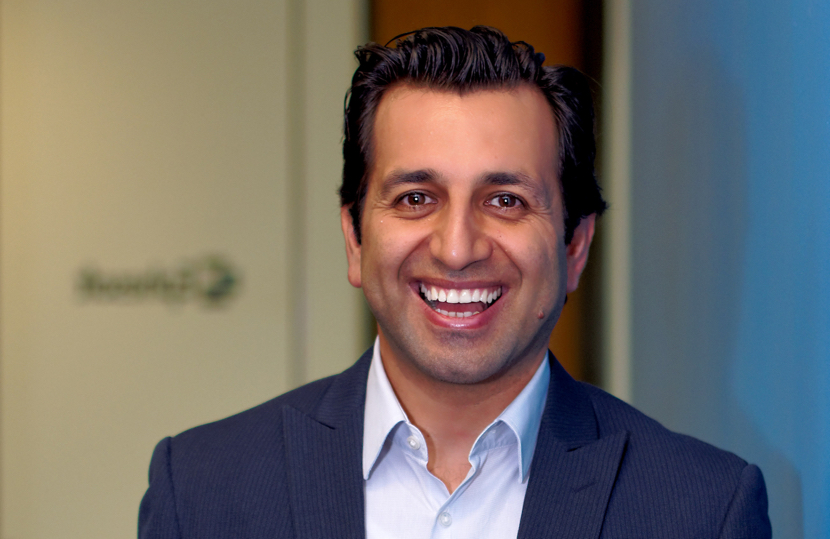
Ike Kavas founded Ephesoft seven years ago, which now boasts 550 customers. Unlike a lot of Silicon Valley startups, Ephesoft has been profitable for the last five of those seven years and was recently named to the Inc. 500 fastest-growing privately held companies in America. So, what exactly is Kavas cooking up over there?
Ike Kavas, who recently took over the helm of the company that he founded seven years ago, is on a mission to drive innovation in a space where it's badly needed—the document capture software market. He's not shy either about his promise to deliver innovation every two years through his work at Ephesoft, a provider of cloud-based document capture and analytics technology.
Mr. Kavas started his career working with document management and workflow tools but quickly pivoted toward document capture products. He eventually found himself at Kofax within their professional services division where he spent his days implementing solutions and processing billions of documents a year for his clients, but he soon began to realize that the current market players weren't doing enough to revolutionize the capture industry. Taking his knowledge from years of project work, he began to synthesize his vision for an easy, intelligent document capture solution not just for the Fortune 500—but for the Fortune 50,000. DOCUMENT Strategy Editor Allison Lloyd sat down with Kavas to explore what intelligent document capture means, the role of analytics for all that data stored in our repositories, and if artificial intelligence (AI) is more than just hype.
When you say that you didn't see enough innovation emerging from the document capture space, in your mind, what were some of the biggest pitfalls of this technology?
At the time, capture products only dealt with the ingestion of documents into systems, like repositories and document management systems, or into a workflow to be stored. Everybody talked about the first mile of document processing, and we never really got out of that. Document capture didn't address handling documents after they've been stored and how to data mine them. I wanted to change that.
The technology also required a lot of professional services, so it was not only expensive to purchase but also expensive to implement. I think this is one of the reasons why document capture remained at the Fortune 500 level. From a technical perspective, it was always based on 1980's architecture. Nobody was creating cloud, web-based solutions. Everybody was stuck in the past.
What does intelligent capture mean to you?
The number of documents that companies receive and exchange with each other only keeps growing, and they are all electronic. The definition of intelligent capture is the ability to recognize different variations of documents and understand what they are. Over the years, forms and documents have changed greatly. Intelligent document capture handles a wide variety of document content, and it's smart enough to be able to categorize, sort, and extract data so you don't have to do it with labor-intensive processes.
What do you think is the future of document capture?
I think companies, like Ephesoft, must be all-encompassing when it comes to document processing. For example, we built machine learning into our solution to actually classify and extract documents coming into the organization, mobile SDKs to help enable capture on mobile systems, APIs to connect to other internal or customer-facing systems, and analytics for documents that we've collected for the past 30 years so we can turn this unstructured data into knowledge. Document capture companies must provide these all-encompassing tools around documents from beginning to end.
Speaking of analytics, what should organizations think about when trying to use their content beyond just storing it?
We've always scanned documents and only captured a few data points to just run the business for that day, whether it's an invoice, lab report, or a lease contract. In the past, it was so expensive for any company to enter pages and pages of data into a system and analyze it. You would have to hire thousands of people just to enter all that data. Now, software allows companies to go back into that repository, extract all that data off of their documents without the cost of labor, and turn it into analytics so analysts can actually make decisions. This allows us to create information about our customers, improve customer engagement, and maybe even create marketing opportunities from data just sitting on documents for years.
There is a lot of skepticism around real-word application of AI, analytics, and machine learning. Can organizations actually use these technologies to solve business problems?
Our approach is very practical, and our goal is to reduce the need for professional services to implement a project so our customers can see benefits immediately. As part of our design principles, we eliminated deep learning, which equals collecting hundreds of samples to do something. There are so many AI companies out there that say, "If you give me a million samples, I can make something for you." We advocate supervised machine learning so that when you give one or two samples, the software can learn from the person in front of it to improve the system slowly. We believe that users are knowledgeable. We just need to enhance those abilities.
This interview has been lightly edited and condensed.
The technology also required a lot of professional services, so it was not only expensive to purchase but also expensive to implement. I think this is one of the reasons why document capture remained at the Fortune 500 level. From a technical perspective, it was always based on 1980's architecture. Nobody was creating cloud, web-based solutions. Everybody was stuck in the past.
What does intelligent capture mean to you?
The number of documents that companies receive and exchange with each other only keeps growing, and they are all electronic. The definition of intelligent capture is the ability to recognize different variations of documents and understand what they are. Over the years, forms and documents have changed greatly. Intelligent document capture handles a wide variety of document content, and it's smart enough to be able to categorize, sort, and extract data so you don't have to do it with labor-intensive processes.
What do you think is the future of document capture?
I think companies, like Ephesoft, must be all-encompassing when it comes to document processing. For example, we built machine learning into our solution to actually classify and extract documents coming into the organization, mobile SDKs to help enable capture on mobile systems, APIs to connect to other internal or customer-facing systems, and analytics for documents that we've collected for the past 30 years so we can turn this unstructured data into knowledge. Document capture companies must provide these all-encompassing tools around documents from beginning to end.
Speaking of analytics, what should organizations think about when trying to use their content beyond just storing it?
We've always scanned documents and only captured a few data points to just run the business for that day, whether it's an invoice, lab report, or a lease contract. In the past, it was so expensive for any company to enter pages and pages of data into a system and analyze it. You would have to hire thousands of people just to enter all that data. Now, software allows companies to go back into that repository, extract all that data off of their documents without the cost of labor, and turn it into analytics so analysts can actually make decisions. This allows us to create information about our customers, improve customer engagement, and maybe even create marketing opportunities from data just sitting on documents for years.
There is a lot of skepticism around real-word application of AI, analytics, and machine learning. Can organizations actually use these technologies to solve business problems?
Our approach is very practical, and our goal is to reduce the need for professional services to implement a project so our customers can see benefits immediately. As part of our design principles, we eliminated deep learning, which equals collecting hundreds of samples to do something. There are so many AI companies out there that say, "If you give me a million samples, I can make something for you." We advocate supervised machine learning so that when you give one or two samples, the software can learn from the person in front of it to improve the system slowly. We believe that users are knowledgeable. We just need to enhance those abilities.
This interview has been lightly edited and condensed.




